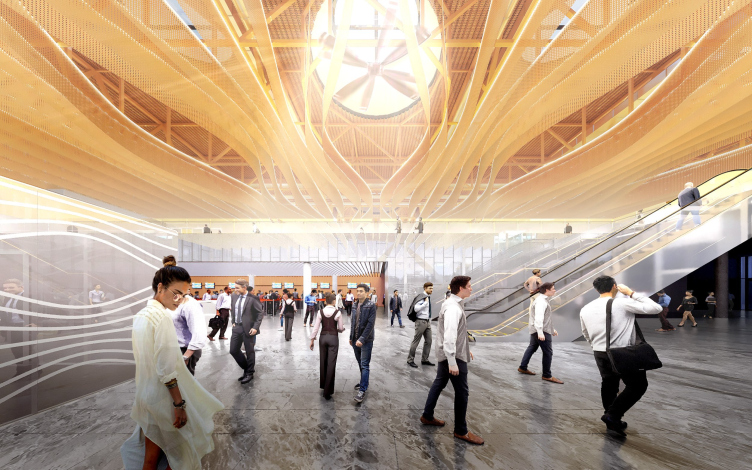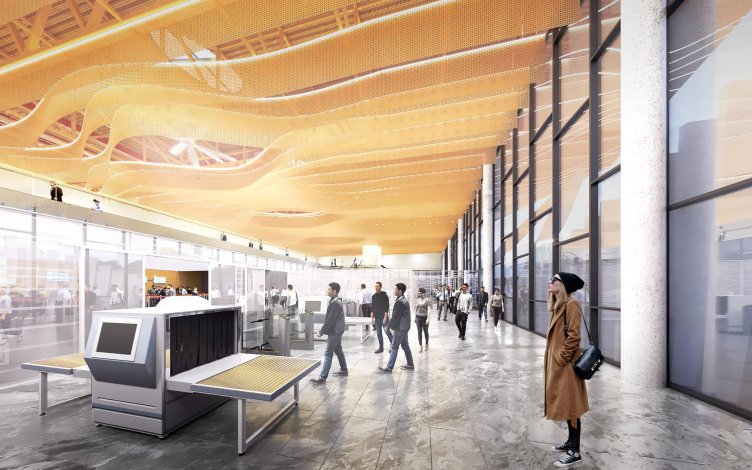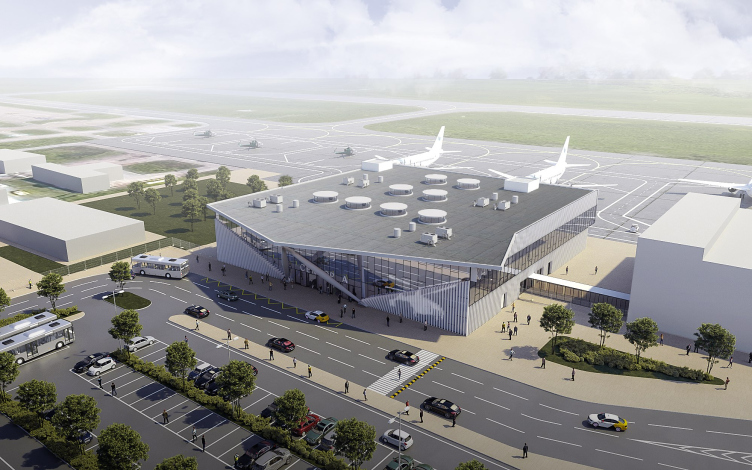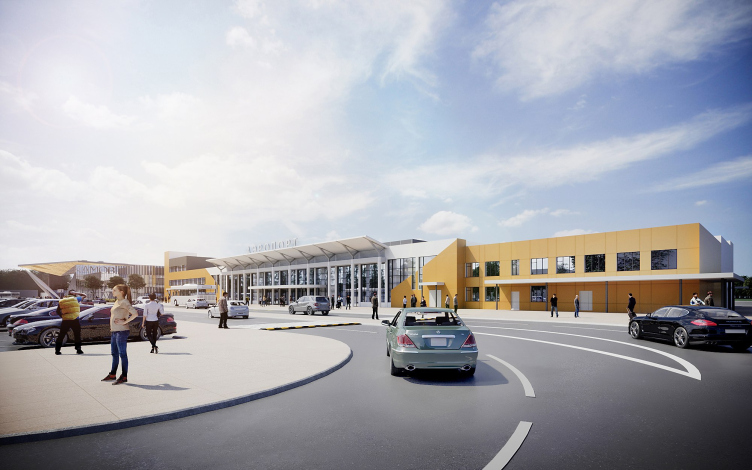The terminal’s client is the Novaport company, Russia’s largest chain of regional airports, working with which ASADOV bureau designed and built facilities in Perm and Kemerovo.
A regional airport is the typology, in which nowadays it is fashionable to “crank up” the identity to very high levels, and all this in spite of the fact that the terminals are oftentimes located in a windswept field or in an industrial area – but then again, the absence of immediate context leaves more freedom for flashy accents. It is a place where it is appropriate to tell the guests and remind the residents about the things that the city has to offer.
In Tomsk, the architects proceeded from the name of the airport: in 2018, it was named after Nikolai Kamov – the aircraft designer, founder of the Soviet helicopter industry, who coined the word “vertolet” that is now used in the modern Russian language instead of the English “helicopter”. Under the leadership of Nikolai Kamov and Mikhail Mil, the production of the world-famous helicopters “Ka” and “Mi” began. Nikolai Kamov studied in Tomsk; he entered the Institute of Technology at the age of 16. One cannot say that the engineer’s ideas are reflected in the building in any literal way – and at the same time it is obvious that they were the source of inspiration.
The new terminal is situated on the left of the old one and has a plan that is very close to a perfect square – the volume is technology-determined and was set well in advance, so ASADOV bureau worked on breathing architecture into this parallelepiped.
Tomsk airport named after Nikolai Kamov
Copyright: © ASADOV Architects
At this point, we can recall that the main feature of Nikolai Kamov’s helicopters was a twin-screw coaxial scheme, in which a pair of rotors installed in parallel rotates in opposite directions on a single geometric axis. It seems that in the solution of the main facade one can see some vague allusions to this invention – not literal, of course, but still quite readable: the wings, the air streams, the axles and blades definitely play an important part in the airport’s imagery.
In one brisk motion, pointed from the bottom upwards and from the edges towards the center, two large spindle-like columns converge in the center before the main entrance. The entire facade is determined by their symmetrical impulse: it looks as though the incoming passengers are welcomed by a giant “emerging” aircraft that unfolds the golden “wing” of the marquee reflected in the glass of the facade. At the same time, a row of lamellas below is smoothly bent – the way grass would underneath rotating blades; the analogy is further strengthened by the images of helicopters on the metallic surfaces. The resulting image is something in the middle between a hang glider and a rotorcraft.
Tomsk airport named after Nikolai Kamov
Copyright: © ASADOV Architects
Tomsk airport named after Nikolai Kamov
Copyright: © ASADOV Architects
On the side, the similarity between the marquee and a hang glider is particularly strong; the lines are simple and laconic, and the “forward and upward” impulse makes one think not just about the theme of flight, quite justified in this case, but also some retro-note, remindful of the Worker and Kolkhoz Woman monument, and even of the reserved and light style of the Soviet terminals.
Let us also take a look at the characters of the “Kamov” name – its slender font looks very much like the one that was used in the airport during the Soviet time. A font just as slender is used to write the city name of Tomsk from the side of the runways and boarding bridges.
Tomsk airport named after Nikolai Kamov
Copyright: © ASADOV Architects
Tomsk airport named after Nikolai Kamov
Copyright: © ASADOV Architects
Currently, it is yet unknown what the interiors of the terminal will ultimately look like, but within the project the principle of the connection between the outside and inside solutions was fully implemented. Behind the golden marquee in the glowing waves on the inside, there is a ceiling of the same color with circular skylights, in which the bladed fans are installed. These put one in the mind of art house cinema, but even more about helicopters. The smooth waves of the noise-canceling suspended from the ceiling visualize the streams of air “moved by the blades”, and, absorbing the noise, at the same time mask the bearing structures – and by these economical means form a “living” and nonlinear surface, positive-looking and glowing with yellow warmth. This is cost-effective, cozy, positive, and, thanks to the yellow color, even jolly-looking. Let’s live and see how the interior solution will be implemented.
Tomsk airport named after Nikolai Kamov
Copyright: © ASADOV Architects
Tomsk airport named after Nikolai Kamov
Copyright: © ASADOV Architects
The skylights on the roof also continue the theme of modernist roots and unassuming Soviet expressiveness: their cylinders are shifted upwards, and, when viewed from above, they look like buttons on a dashboard – so that the “fifth facade” of the terminal (which sometimes is indeed visible from the airplane cabin!) is also carefully thought out. At the same time, the similarity between the “button” skylights and the large colored “mushrooms” of Pulkovo-1 seems rather obvious.
Tomsk airport named after Nikolai Kamov
Copyright: © ASADOV Architects
Tomsk airport named after Nikolai Kamov
Copyright: © ASADOV Architects
The new terminal is connected to the old one with a covered passage. The ASADOV architects proposed the option of re-cladding the facades of the terminal: it is also dominated by light gray and warm yellow, and the old terminal also has a wing-like marquee, so that the buildings should turn into a single complex.
Tomsk airport named after Nikolai Kamov
Copyright: © ASADOV Architects
Tomsk airport named after Nikolai Kamov
Copyright: © ASADOV Architects














































